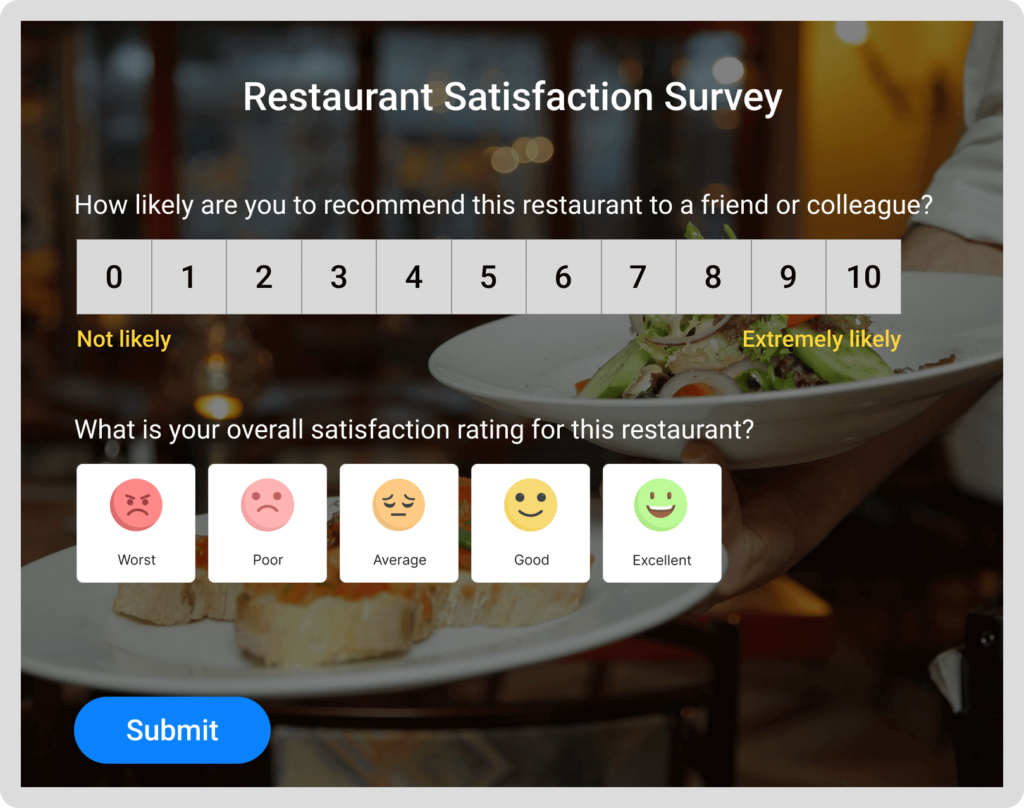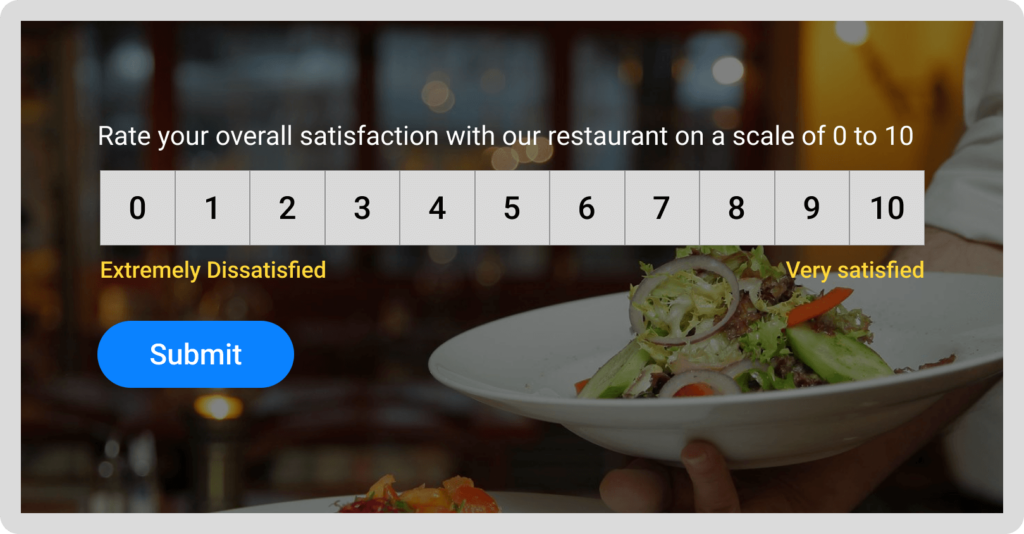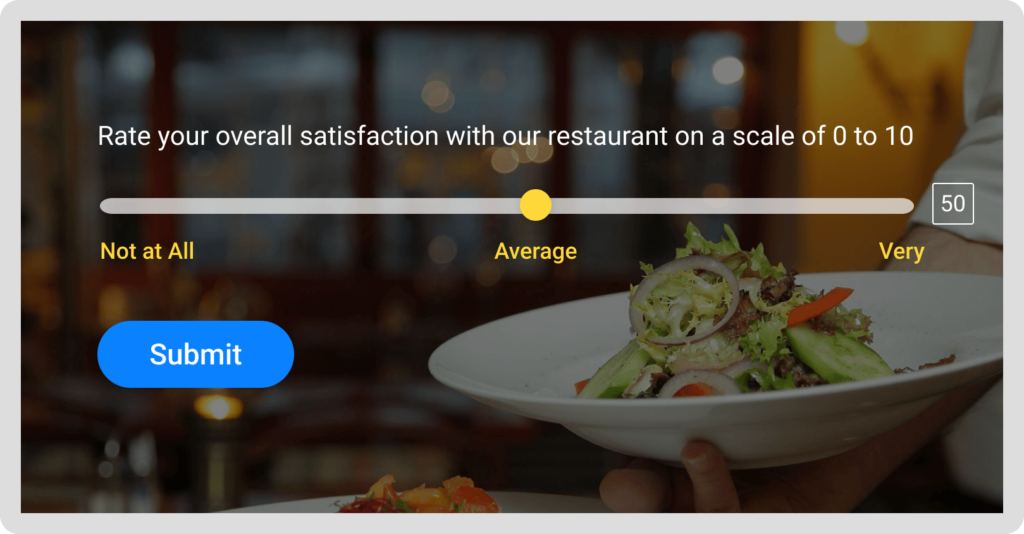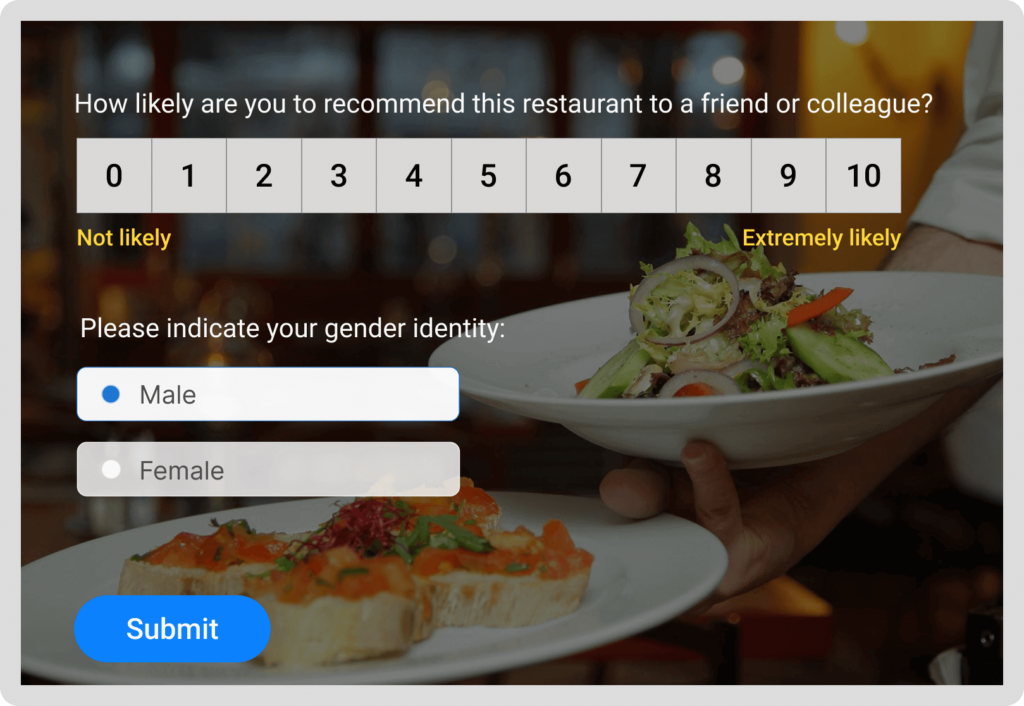
Ever wonder what your guests really think after a meal at your restaurant? Sure, empty plates can be a good sign, but wouldn’t it be fantastic to gather detailed feedback to improve the whole experience?
That’s where well-crafted restaurant survey questions come in – the easiest and most reliable way to understand your customers’ wants and needs.
But what should you ask, and how?
In this guide, we’ll explore all that, along with their types, benefits, and implementation tips.
Here’s to transforming your eatery into a delightful culinary haven. Let’s go!
Example of a Restaurant Dine-in Feedback Form
The restaurant industry mostly relies on repeat customers, and the only way to know if people will visit you again is by sharing the right survey at the right time. An accurately designed restaurant survey will give quantitative and qualitative insight into the customer mindset.
Let’s look at a well-balanced restaurant survey that covers all these aspects:

Restaurant Survey Questions: Types & Examples
Crafting a successful restaurant survey questionnaire requires a strategic approach if you wish to understand the entire customer journey, from the moment they walk in, to the moment they leave (and hopefully, return again soon!)
Here’s a breakdown of key question types that make a comprehensive survey:
2. Gauging Overall Satisfaction: Setting the Tone
These questions serve as the foundation of your survey, capturing a general sense of your customer’s happiness with your restaurant.
Examples:
- Rate your overall satisfaction with our restaurant on a scale of 0 to 10.

- How satisfied were you with your overall dining experience today? (Very satisfied/Somewhat satisfied/Neutral/Dissatisfied/Extremely Dissatisfied)
- What was your first impression upon entering our restaurant? (Open Ended)
- How easy was it to find our location? (Excellent/Very Good/Good/Fair/Poor)
- What did you enjoy most about your dining experience today?
2. Food Quality: The Heart of the Matter
Let’s face it, the food is the star of the show. Questions here delve into the quality, taste, and presentation of the culinary creations.
Examples:
- How would you rate the taste of the dishes you ordered? (Excellent/Good/Average/Poor/Extremely poor)
- Was the food served at the right temperature? (Yes/No)
- Is there anything specific on the menu you particularly enjoyed?
- What type of cuisine or dishes would you like to see offered in the future?
- Were the drinks (alcoholic & non-alcoholic) refreshing and enjoyable? (Yes/No)
3. Service Quality: The Human Touch
Friendly, attentive service can elevate a good meal to a great one. These questions assess how well your staff performed.
Examples:
- How would you rate the friendliness and professionalism of our staff? (Excellent/Good/Average/Poor/Extremely poor)
- Did your server attend to your needs promptly? (Yes/No)
- How attentive and professional was your server? (Excellent/Very Good/Good/Fair/Poor)
- Did your server answer your questions about the menu clearly and informatively? (Yes/No) 1 10. Did the wait time for your food and drinks seem reasonable? (Yes/No)
- Did the staff make you feel welcome and comfortable throughout your visit? (Yes/No)
4. Cleanliness and Ambiance: Setting the Scene
Cleanliness and ambiance questions help ensure your restaurant meets hygiene standards and creates a pleasant environment. The overall atmosphere plays a significant role in customer satisfaction.
Examples:
- How clean was the restaurant during your visit? (Not at All/Average/Very)

- How clean were the restrooms and dining areas? (Excellent/Very Good/Good/Fair/Poor)
- Was the noise level in the restaurant comfortable for conversation? (Yes/No)
- How would you describe the overall ambiance of the restaurant? (Relaxing/Lively/Romantic/Elegant/Other)
- Was the temperature in the restaurant comfortable? (Yes/No)
5. Menu and Pricing: Finding the Sweet Spot
Understanding customer sentiment towards your menu and pricing strategy is crucial. Knowing if your menu offers enough choices or caters to dietary needs with the right pricing is essential for attracting and retaining customers.
Examples:
- How would you rate the taste and quality of the food you ordered? (Excellent/Very Good/Good/Fair/Poor)
- Were you satisfied with the portion sizes? (Yes/No)
- Did the menu offer various options to suit your dietary needs (vegetarian, vegan, gluten-free)? (Yes/No)
- How would you rate the value for money of our menu items? (Excellent/Very Good/Good/Fair/Poor)
6. Recommendation Questions: The Seal of Approval
These questions assess how likely customers are to recommend your restaurant, a strong indicator of overall satisfaction. Understanding repeat customer intention helps gauge long-term success and the effectiveness of your efforts in creating a memorable dining experience.
Examples:
- How likely are you to recommend our restaurant to a friend or family member? (Very Likely/Likely/Neutral/Unlikely/Very Unlikely)
- What is one thing we could have done to make your dining experience even better? (Open Ended)
- Would you visit our restaurant again? (Yes/No)
7. Open-Ended Questions: Capturing Qualitative Data
Open-ended questions allow customers to express their thoughts and feelings in their own words. Don’t underestimate their power!
- Example: “What did you enjoy the most about your dining experience?” – This can reveal unexpected delights that contribute to customer satisfaction.
- Example: “Do you have any suggestions for improving our service or menu?” – These questions can be goldmines for actionable insights to elevate your offerings.
| Pro Tip: Avoid overwhelming your customers with too many open-ended questions. Consider using them strategically to follow up on specific aspects of the dining experience. |
8. Demographic Questions: Understanding Your Audience
While optional, demographic questions can provide valuable context to your survey data and allow you to tailor your offerings to specific demographics. As an added perk, knowing your customers’ dining frequency also helps assess your restaurant’s positioning within the competitive landscape.
Examples:
- What is your age group? (18-24/25-34/35-44/45-54/55+)
- How often do you typically dine out at restaurants? (Once a week/Once a month/ Few times a year/Rarely)
- How did you hear about our restaurant? (Peer recommendation/Internet/Flyers/Other)
- Did we celebrate a special occasion during your visit? If so, what was it? (Birthday/Anniversary/Other) (Optional)
- Did you take advantage of any online ordering or reservation services we offer? If so, how was your experience? (Yes/No)
By incorporating this variety of question types, you’ll craft a comprehensive survey that clearly outlines your restaurant’s strengths and weaknesses.
| Bonus Tip: Keep your survey concise and user-friendly. People are busy, so respect their time. Consider a mix of question formats to avoid monotony and ensure a smooth survey experience. If you are looking for inspiration, try our readymade templates or ask ProProfs AI to generate one for you! |
How to Create Effective Restaurant Survey Questions?
Creating an effective restaurant survey requires thoughtful planning and a keen understanding of what information you need to gather. Here are some tips to help you craft surveys that yield valuable insights without overwhelming your respondents:
1. Keep it Concise
Aim for 15-20 questions to ensure the survey is comprehensive but not overwhelming. Long surveys can lead to respondent fatigue, resulting in incomplete responses or skewed data. Focus on the most important aspects you want to evaluate.
2. Offer a Mix of Question Formats
Using a variety of question types can keep the survey engaging and capture different kinds of information:
- Multiple Choice Questions: These are great for gathering quantitative data and are easy for respondents to answer quickly.
- Likert Scale Questions: Use these to measure the intensity of respondents’ feelings or opinions on a scale (e.g., 1 to 5, from “strongly disagree” to “strongly agree”).
- Open-Ended Questions: These allow respondents to provide more detailed feedback and insights that might not be captured through structured questions.
3. Ensure Questions Are Clear and Specific
Avoid ambiguous or leading questions. Make sure each question is straightforward and focuses on a single aspect to avoid confusion. For instance, instead of asking, “How was your meal and service?” split it into two questions: “How would you rate your meal?” and “How would you rate the service?”
4. Tailor Questions to Your Goals
Identify what you want to learn from the survey and tailor your questions accordingly. Are you looking to improve food quality, service, ambiance, or something else? Make sure your questions align with these goals.
5. Include Demographic Questions
Adding a few demographic questions can help you understand your customer base better. Ask about age, gender, visit frequency, or other relevant demographics to segment your data and identify trends.
6. Provide a User-Friendly Survey Platform
Choose a survey platform that is easy to use for both you and your respondents. It should be mobile-friendly, quick to load, and simple to navigate. Platforms like ProProfs Survey Maker are great because they offer customizable templates and advanced settings.
7. Pilot Test Your Survey
Before sending out the survey to all your customers, conduct a pilot test with a small group. This can help you identify any confusing questions or technical issues. Use their feedback to refine the survey.
8. Express Gratitude to Your Customers
Always thank your respondents for their time and feedback. A simple thank you message at the end of the survey can go a long way in making customers feel appreciated and valued.
9. Analyze and Act on the Feedback
Collecting feedback is only valuable if you act on it. Analyze the survey results to identify areas for improvement and implement changes based on the insights you gather. Communicate any improvements or changes made as a result of customer feedback to show that their input is valued.
What Are the Benefits of Conducting a Restaurant Survey?
Running a restaurant is a delicate dance between culinary creativity and exceptional customer service. But even the most talented chefs and attentive waitstaff can struggle to understand their guests’ true dining experience.

Restaurant surveys help mine real data from customers about their satisfaction levels, overall dining experience, quality of food, support staff service, and a lot more.
Here are the rewards you can reap from conducting restaurant surveys:
- Uncover Hidden Gems: Surveys act as a direct line to your customers’ thoughts and feelings. They reveal what they loved about their experience – was it the melt-in-your-mouth appetizers, the attentive service, or the vibrant atmosphere? This allows you to identify and capitalize on your strengths.
- Pinpoint Areas for Improvement: No restaurant is perfect. Surveys can expose areas that might be hindering customer satisfaction, like slow wait times, limited menu options, or uncomfortable seating. By identifying these weaknesses, you can take targeted action and create a more enjoyable dining experience for everyone.
- Boost Customer Loyalty: Showing your customers you value their feedback demonstrates a commitment to continuous improvement. This fosters a sense of connection and loyalty, encouraging them to return and recommend your restaurant to others.
- Make Data-Driven Decisions: Surveys provide valuable data that goes beyond just opinions. By analyzing responses, you can identify trends, measure the effectiveness of new menu items or promotions, and make informed decisions about your restaurant’s future.
- Gain a Competitive Edge: The culinary landscape is crowded and heavily competitive, and understanding your customers’ preferences thoroughly is key to standing out. Surveys provide valuable insights that allow you to tailor your offerings to local tastes and preferences, giving you the much-needed competitive edge.
Watch: How to Measure Customer Satisfaction
FREE. All Features. FOREVER!
Try our Forever FREE account with all premium features!
Ways to Take Restaurant Feedback
Let’s now take a look at various methods to capture guest thoughts and feelings:
1. The Classic: Post-Visit Surveys
- Digital: Email surveys are convenient and widely used. To boost response rates, keep them concise (10-15 questions) and offer an incentive (discount).
- Paper: Leave comment cards or short surveys on tables. It’s a simple, low-tech option, but might have lower response rates.
2. Leverage Technology:
- Mobile App Surveys: Integrate surveys into your restaurant’s mobile app for a seamless experience. Offer loyalty points or rewards for completion.
- QR Codes: Place QR codes on coasters, menus, or restrooms, linking to a quick online survey.
3. Face-to-Face Feedback:
- Manager Check-Ins: Encourage your managers to personally connect with guests during their meal, asking open-ended questions about their experience.
- Post-Payment Inquiry: Train servers to politely ask for feedback as guests settle their bills.
4. Embrace Social Media:
- Gather Reviews: Prompt happy customers to leave positive reviews on platforms like Yelp, Google, or Facebook. Respond to all reviews, thanking positive feedback and addressing concerns.
- Social Listening: Actively monitor social media for mentions of your restaurant. Identify trends and address any negative feedback promptly.
5. Go Beyond the Meal:
- Mystery Diners: Hire a mystery diner to pose as a regular customer and provide an unbiased evaluation of the entire dining experience.
- Focus Groups: Conduct small group discussions to gain in-depth insights into specific aspects like menu choices or ambiance.
Use Restaurant Feedback to Improve Your Services
The culinary business is a competitive one, and you must improve yourself every day to get ahead of competitors. Truth be told, no strategy is as important as directly asking your customers what they want, and modifying your model accordingly.
By prioritizing feedback through creative methods, you can collect actionable insights that will help you refine your offerings, elevate service, and cultivate a loyal following.
Think of feedback as a continuous conversation with your guests. It allows you to identify what delights them and address any areas that might be hindering their experience.
Remember, even negative feedback is a valuable gift – it unveils opportunities for improvement and ensures you’re constantly evolving to meet the ever-changing needs of your diners.
After all, in the world of restaurants, it’s not just about filling plates; it’s about creating memories. Make yours the ones your guests will rave about!
To know more, sign up for free or get a demo.
Frequently Asked Questions
Q: What’s the purpose of a restaurant survey?
A: Restaurant surveys gather feedback to improve food, service, and ambiance, leading to happier guests and a stronger business.
Q: What questions should I ask?
A: Ask about overall satisfaction, food quality (taste, presentation, options), service (attentiveness, friendliness), and ambiance (cleanliness, noise level). Include open-ended questions for unexpected insights.
Q: Why gather restaurant feedback?
A: Feedback helps you improve your restaurant, build customer loyalty, gain a competitive edge, and meet evolving customer expectations.
FREE. All Features. FOREVER!
Try our Forever FREE account with all premium features!
 We'd love your feedback!
We'd love your feedback!
 Thanks for your feedback!
Thanks for your feedback!






